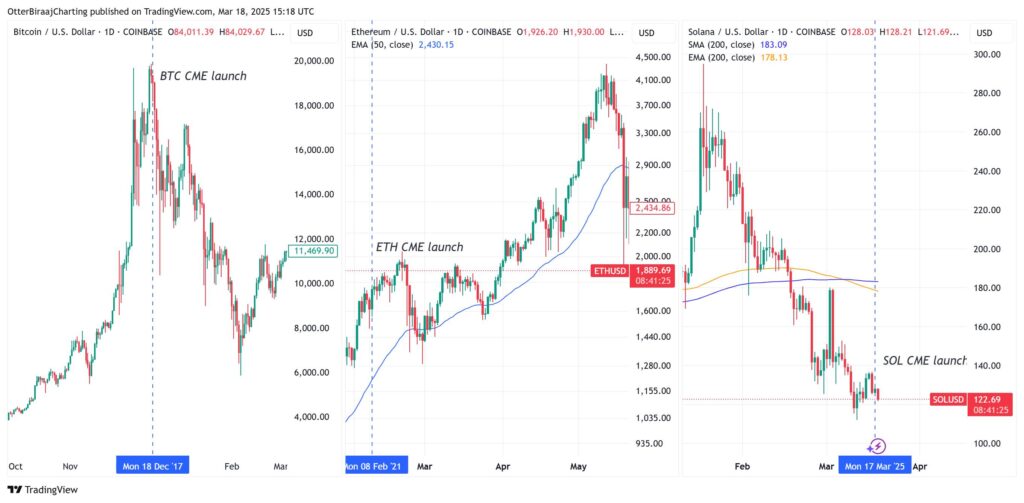In an exciting development for the cryptocurrency market, Solana (SOL) futures officially launched on the Chicago Mercantile Exchange (CME) on March 17, marking a new chapter for the crypto asset. On its inaugural trading day, SOL futures recorded a trading volume of .1 million. While this figure is impressive on its own, it notably fell short when compared to the initial debuts of Bitcoin (BTC) and Ethereum (ETH) futures, which both enjoyed significantly higher trading volumes at launch.
“When we look at SOL’s trading performance through the lens of normalized volumes relative to market cap, it surprisingly aligns more closely with Bitcoin and Ethereum than one might expect,” stated Vetle Lunde, Head of Research at K33Research.
In examining these normalized volumes, which gauge trading activity against each cryptocurrency’s market capitalization, Bitcoin led the pack with a normalized volume of 0.0319%. Ethereum followed at 0.0173%, while Solana came in just slightly behind at 0.0166%. This suggests that despite a lower absolute trading volume, investor engagement with Solana on its launch day was not drastically different from that of Ethereum.
The launch of SOL futures is particularly significant amid a broader market bullishness driven by past successes such as spot ETF approvals and CME futures contracts. Historically, these events have bolstered investor interest across various cryptocurrencies. However, the immediate aftermath of SOL’s launch raises questions about its potential trajectory in the current bull market. Unlike Bitcoin, which saw a notable price drop following its futures launch, Ethereum experienced an impressive rally, increasing by 150% in the months after its CME debut.
“While SOL’s immediate price reaction post-launch hasn’t generated much enthusiasm, its positioning within the CME could enhance liquidity and attract institutional players over time,” noted market analysts.
As the landscape continues to evolve, SOL’s presence on the CME allows for greater price discovery and positioning within the market. Whether it can replicate the success of Bitcoin or Ethereum in the long run remains to be seen, but the implications of its futures launch could unfold as market conditions and investor sentiment further develop.
Solana Futures Launch on CME: Key Insights
On March 17, the Chicago Mercantile Exchange (CME) debuted Solana (SOL) futures, marking a notable event in the cryptocurrency landscape. Here are the key points regarding this launch and its implications:
- Initial Trading Volume:
Solana futures launched with a trading volume of .1 million on day one, which is significantly lower than Bitcoin (BTC) and Ethereum (ETH) during their respective futures launches.
- Normalized Volume Analysis:
When normalized to market capitalization, Solana’s trading volume aligns more closely with BTC and ETH, suggesting comparable trading activity relative to its market cap.
- Investor Sentiment:
The performance of CME futures contracts has generally boosted investor sentiment in cryptocurrencies, with previous launches leading to increased market activity.
- Comparative Performance:
- Bitcoin recorded the highest normalized volume at 0.0319%.
- Ethereum followed with a normalized volume of 0.0173%, while Solana was slightly lower at 0.0166%.
- This indicates that investor interest, when adjusted for market cap, is relatively similar between ETH and SOL.
- Potential Price Effects:
Historically, the launches of futures have led to significant price movements. For instance, BTC saw a sharp decline following its launch, while ETH experienced a substantial rally. Solana’s lack of immediate upward movement post-launch may suggest a less enthusiastic reaction from investors.
- Long-term Outlook:
Despite the initial trading volume, Solana’s presence on CME offers increased opportunities for liquidity and price discovery, which could attract institutional engagement over time, especially if market conditions improve.
This information is crucial for investors and traders as it provides insights into how the launch of futures can impact cryptocurrency valuations and market sentiment over the long term.
Analyzing the Competitive Landscape of Solana CME Futures
The launch of Solana (SOL) futures on the Chicago Mercantile Exchange (CME) has generated mixed reactions within the cryptocurrency community. While the debut on March 17 came with a notable trading volume of .1 million, it quickly became apparent that this figure paled in comparison to the initial performances of Bitcoin (BTC) and Ethereum (ETH). This disparity raises important questions regarding the competitive positioning of Solana in the crypto futures marketplace.
One of the key insights from Vetle Lunde, Head of Research at K33 Research, is the evaluation of normalized trading volumes relative to market cap, which paints a more nuanced picture. Despite SOL’s absolute trading volume falling short of BTC and ETH by over million on day one, the close alignment of its normalized volume with ETH suggests that Solana’s market engagement is not as far behind as the raw numbers might indicate. This could highlight a potentially bright future for SOL, provided that institutional interest continues to develop over time.
However, the launch’s immediate performance prompts concerns for Solana’s market position. Unlike its predecessors that demonstrated significant price rallies post-launch, SOL saw a lack of upward momentum, indicating either a tepid reception among investors or a broader market sentiment that is not as optimistic towards Solana. In contrast, Bitcoin’s futures were initially followed by a steep decline, while Ethereum capitalized on its launch to achieve substantial gains shortly after. This history of performance raises skepticism about whether SOL can replicate such success in the longer term. The absence of immediate positive market reaction may discourage potential traders and investors, making it a tougher environment for Solana to navigate.
From a competitive advantage standpoint, having CME futures could enhance Solana’s credibility and elevate its liquidity—elements that are essential for attracting institutional investors. This could be particularly beneficial for traders looking for diverse exposure among major cryptocurrencies. Conversely, Solana’s launch experience could deter new participants who may prefer to engage with more familiar narratives tied to BTC and ETH, especially given their proven track records in the futures market.
In essence, while Solana’s futures launch is a step toward institutional credibility and potential liquidity enhancement, it simultaneously presents challenges. The comparative lack of immediate investor excitement and trading volume could hinder Solana’s ability to position itself favorably against Bitcoin and Ethereum, complicating the choices for traders and institutions looking to diversify their cryptocurrency portfolios.

















